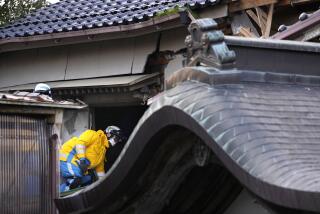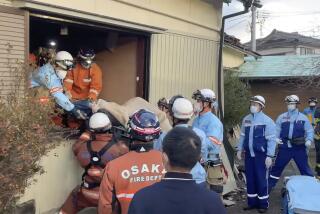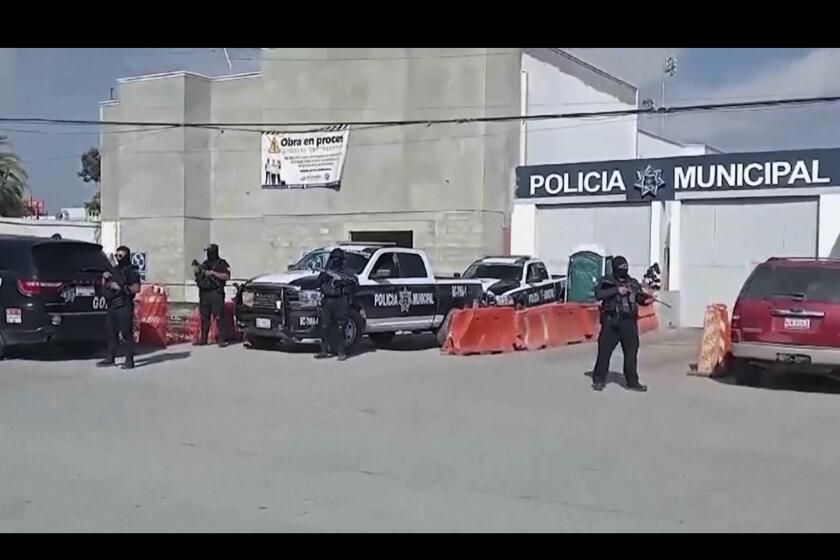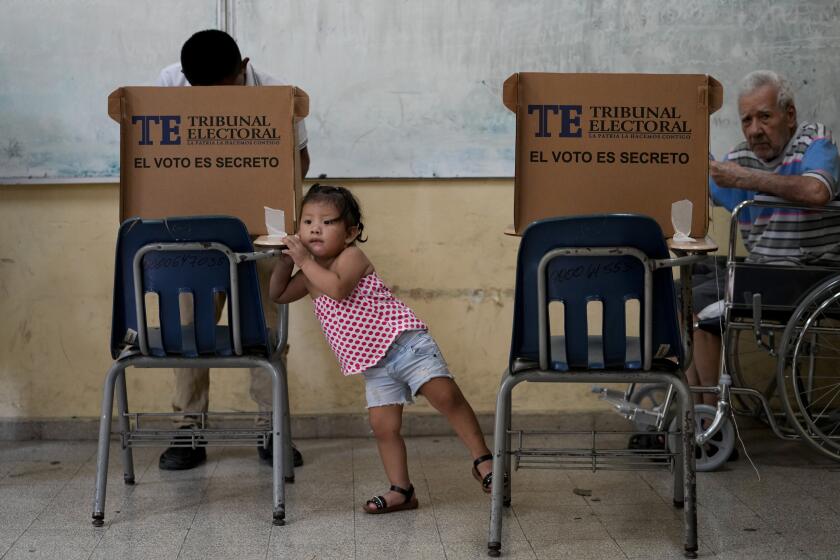Winds, fluctuating radiation levels hamper efforts to control Japan nuclear plant
There was no obvious sign of progress in the battle to take control of the dangerously stricken Fukushima No. 1 (Daiichi) nuclear power plant early Friday, as blustery winds and fluctuating radiation levels hampered efforts to douse hot nuclear equipment with water from helicopters and firetrucks.
“We know that the damage to the nuclear reactors in Fukushima Daiichi plant poses a substantial risk to people who are nearby,” President Obama said Thursday.
The risk was that hot nuclear reactors and spent-fuel pools would heat up without water to cool them down. An uncontrolled heat-up of the nuclear equipment could result in dangerous bursts of radiation into the atmosphere, which is why officials have evacuated the area closest to the power plant.
Photos: Crisis continues in Japan
With some devastated stretches of coastline still untouched by recovery teams, the official toll of dead and missing in last Friday’s massive earthquake and tsunami topped 15,000, as hundreds of thousands of stranded survivors coped with punishing hardships brought on by subfreezing temperatures and shortages of fuel, food and other basic necessities.
Post-quake deaths, particularly among the frail, ill and elderly, were on the rise in sometimes-primitive shelters, some of which lacked heat even as temperatures fell to 21 degrees Fahrenheit overnight.
As of Friday, the official death toll stood at 5,692, according to the National Police Agency, and 9,522 were unaccounted for and feared dead.
Authorities hoped to augment improvised water-spraying tactics on the power plant 150 miles north of Tokyo later Friday or early Saturday with power from a makeshift cable to try to restart pumps that would help cool some of the nuclear equipment.
On Thursday, authorities desperately tried to spray water on the facility by helicopter, but only four loads, totaling about 30 tons, were tossed on the plant before high radiation levels forced them to stop. Most of the water missed the reactors.
The bursts of radiation at the plant also meant that workers will have to be quickly rotated out, and some could rapidly reach their annual exposure limit to radiation. Disaster officials faced a grim choice of scaling back containment efforts or allow workers to face radiation levels that could increase their risk for cancer.
The exodus of foreigners from Japan gathered momentum, with several governments advising their nationals to not only leave the quake zone but also depart from the capital.
In Washington, the State Department reported the first voluntary evacuation flight of U.S. citizens from Japan to Taipei, wire services reported. American officials authorized the voluntary departures of family members and dependents of U.S. government personnel from northeastern Japan.
As many Japanese sought refuge within their homeland, they put more distance between themselves and the crippled nuclear complex, packing aboard trains headed south. The national nightmare is one that envisions a full-scale meltdown at the reactors in Fukushima prefecture, although prevailing winds would probably disperse much of a massive radiation release over the Pacific Ocean.
Obama has assured Americans that the radiation did not pose a risk to U.S. territory.
The Japanese head of the Vienna-based International Atomic Energy Agency was expected to arrive in Japan on Friday, accompanied by international experts. The agency’s Graham Andrew said there had been “no significant worsening” of the situation, but neither was any major progress being reported.
The crisis was roiling financial markets worldwide, and officials from the world’s wealthiest economies planned talks Friday aimed at calming the situation.
Estimates of quake losses could run to $200 billion.
Electricity supplies have become a worrying element of the multipronged crisis. A massive threatened blackout was averted Thursday, but rolling power cuts and voluntary conservation areas are still leaving a shortfall. In the quake zone, Japanese officials said tens of thousands were still without power in unseasonably cold weather. An additional 1.6 million households still do not have running water.
The shortage of gasoline has forced businesses far from the disaster zone to close down and has slowed deliveries of urgently needed humanitarian aid to earthquake and tsunami victims. Hospitals reported running low on medicine.
As snow fell over Sendai, one of the quake zone’s largest cities, people under umbrellas waited in long lines that snaked around blocks to enter the few supermarkets that were open. Gas lines stretched more than a mile.
“This is the biggest disaster since World War II, and they are totally paralyzed,” said Kit Miyamoto, a Japanese American structural engineer who was inspecting damage in tsunami-ravaged Kesennuma.
One shortage often spawned another; people staying in shelters could not get food because they could not drive around looking for it. People used up gas looking for gas.
“The refugees in the sports center are lacking food. If they had the gasoline, they could drive somewhere to get food, but they are stuck here,” said Muneo Saijo, a shopkeeper who was helping evacuees in Kesennuma.
Even a week after the start of the crisis, many struggled to comprehend the level of privation in wealthy Japan.
“We’re an affluent country,” said Masahiko Nagaska, a 32-year-old Panasonic employee in Yamagata, in the heart of the earthquake zone. “But there’s no food on the shelves.”
In Tokyo, trappings of modern life were in disarray. As aftershocks continue rumbling through the capital, ATMs stopped producing cash, and some trains were canceled and neighborhoods were dimmed to conserve energy.
In Washington, officials said the nuclear crisis showed no signs of diminishing. “This is something that will likely take some time to work through, possibly weeks,” said Gregory Jaczko, chairman of the U.S. Nuclear Regulatory Commission.
Higher-than-normal levels of radiation were detected on the clothes of airline passengers from Japan in South Korea and Taiwan, but at levels that did not affect health. Customs officials have detected elements of radiation on cargo containers on flights from Japan that landed in Chicago and Dallas-Fort Worth, but determined that the cargo and passengers aboard were not at risk, the Chicago Tribune reported.
Photos: Crisis continues in Japan
barbara.demick@latimes.com
laura.king@latimes.com
Demick reported from Kesennuma and King from Tokyo. Special correspondent Hall reported from Tokyo. Times staff writer Mark Magnier in Takajo, Japan, Ken Dilanian of the Washington bureau, and Rong-Gong Lin II, Thomas H. Maugh II, and Alan Zarembo in Los Angeles contributed to this report.
More to Read
Start your day right
Sign up for Essential California for news, features and recommendations from the L.A. Times and beyond in your inbox six days a week.
You may occasionally receive promotional content from the Los Angeles Times.






